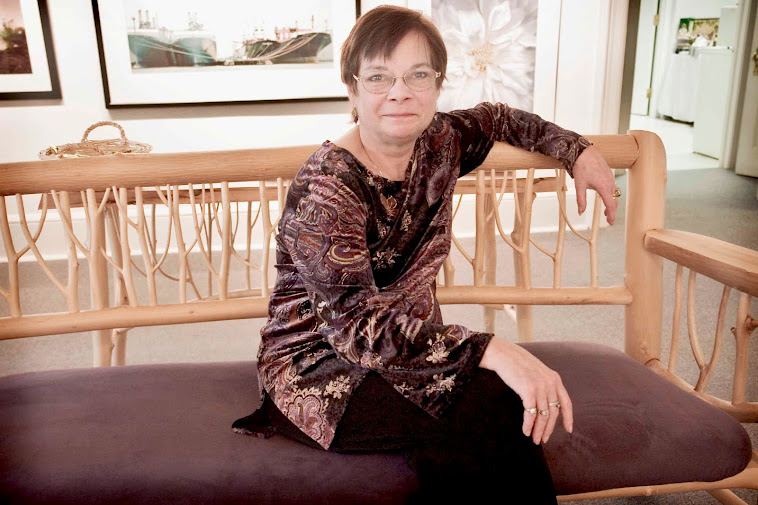The National Gallery of Art (Washington, DC) is hosting a fascinating
exhibition, Faking It: Manipulated
Photography before Photoshop, on view through May 5th. Originating at the Metropolitan Museum of Art
in New York City, this exhibit is billed as “the first major exhibition devoted
to the art of photographic manipulation before the advent of digital imagery.”
Long before there was Photoshop computer software
(introduced in 1990), lots of photographers, both professional and amateur,
were modifying, or manipulating, their images, almost since the day the medium
was invented. Why did they do it? There are a myriad of reasons and this quirky
exhibition attempts to answer as many as possible.
In the 19th century, when there were no color
negatives, photographic artists hand tinted portraits to enhance the features
of the sitter. Also in the 19th
century, there were technical limitations for the films and chemicals. The long exposures necessary to record
details of a landscape rendered the sky blank and without atmospheric
clouds. To compensate, separate
negatives were made for the sky and sandwiched with the landscape
negative. As I will explain later, this
“cloud thing” continued long into the mid twentieth century. Sometimes, the image manipulation was for
political reasons or in an attempt to alter history. Other times, the photographers were playing
around with weird, often macabre, scenes. “Decapitated Man with Head on
Platter,” circa 1865 and “Thirteen Soldiers Holding Severed Heads,” 1910 are
two such examples.
Many of the photographers featured in “Faking It” are well
known to all photography fans: Gustave Le Gray, Carleton Watkins, Weegee, Richard
Avedon, Duane Michals, Jerry Uelsmann, to name just a few, and their stylistic
approach is no great surprise. One of
the riches of this show is the abundance of unknown photographers or ones with
whom I was not familiar. I probably
should have known about Wanda Wulz, but I didn’t. Her charming 1932 portrait, “Io + Gatto (Cat
+ I),” is a collage of her face and her cat’s.
Hard to know who was prettier - the sitter or the feline?
Viewing actual photographs rather than looking at book
illustrations is always a feast for the eyes.
Such is the case with the gorgeous Edward Steichen image, “The Pond,
Moonrise,” 1904 on loan from the Metropolitan Museum of Art, Alfred Stieglitz
Collection 1933. Only three examples of
“The Pond, Moonlight” are known to exist, one of which sold at Sotheby’s in
February 2006 for $2,928,000, a record for the most expensive photograph ever
sold at an auction at that time. How
fortunate we are to have an opportunity to stand in front of a Steichen
masterpiece, absorbing the beauty of this classic pictorial work of art. It is a
stunning example of photographic enhancement,
not manipulation or fakery.
The early 20th century pictorial photographers
were dedicated to making photographs beautiful pictures and any means to that
goal was fair game. Soft focus
romanticism ruled the day and they were willing to take all kinds of artistic
license to create ethereal images.
It was the “pictorial” tradition and aesthetic to which A.
Aubrey Bodine [1906-1970] joined when he started taking photographs in the mid
1920, an approach he rarely deviated from during his five decades of image
making. As most of you know, I have had
the privilege of representing the Bodine photographic estate for many
years. My monograph, A. Aubrey Bodine, Baltimore Pictorialist,
was published by Johns Hopkins University Press in 1985. Research for the book led me to numerous
pictorial journals, which regularly featured articles and instructions of the
benefits of adding clouds to a photograph.
In 1935, one practitioner stated, “Success in picture making is largely
dependent upon knowledge and resource in the matter of skies. The composition of a picture can be
completely changed by the introduction of a well-defined cloud.” I also found copious notes in Bodine’s own
files about the use of separate cloud negatives to embellish a photograph.
For me, “Faking It” implies deception. That was not at all the intention of A.
Aubrey Bodine and his fellow pictorial photographers. He simply did everything in his power to
conjure up some dark room magic and create, what he considered, a better
picture. He made no apologies for
inserting the same cloud formation into “October Field, Baltimore County,
Maryland,” as well as “Springtime, Nova Scotia,” or dozen of other
landscapes. Maybe he thought no one was
paying attention.
October Field: Baltimore County








